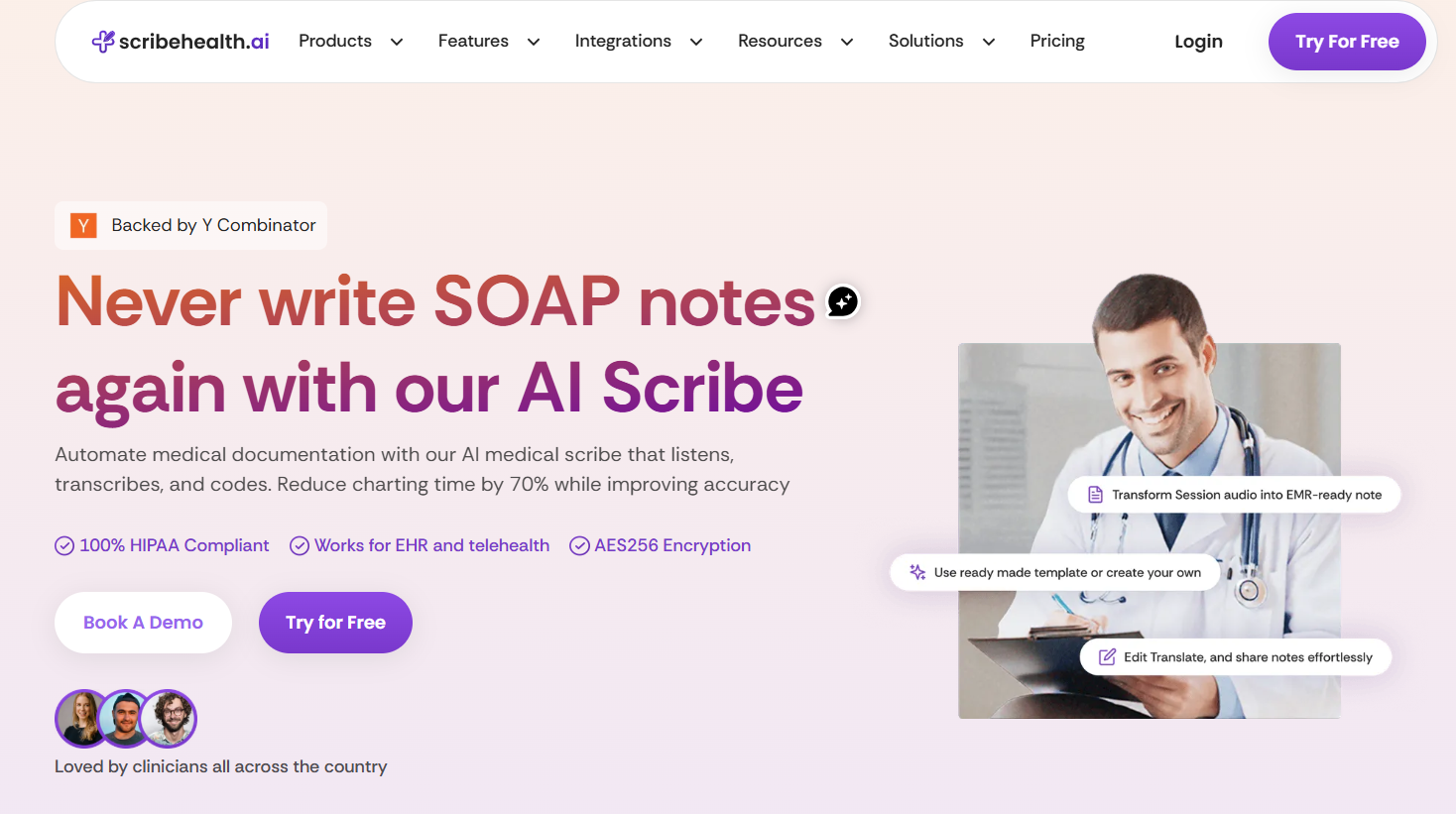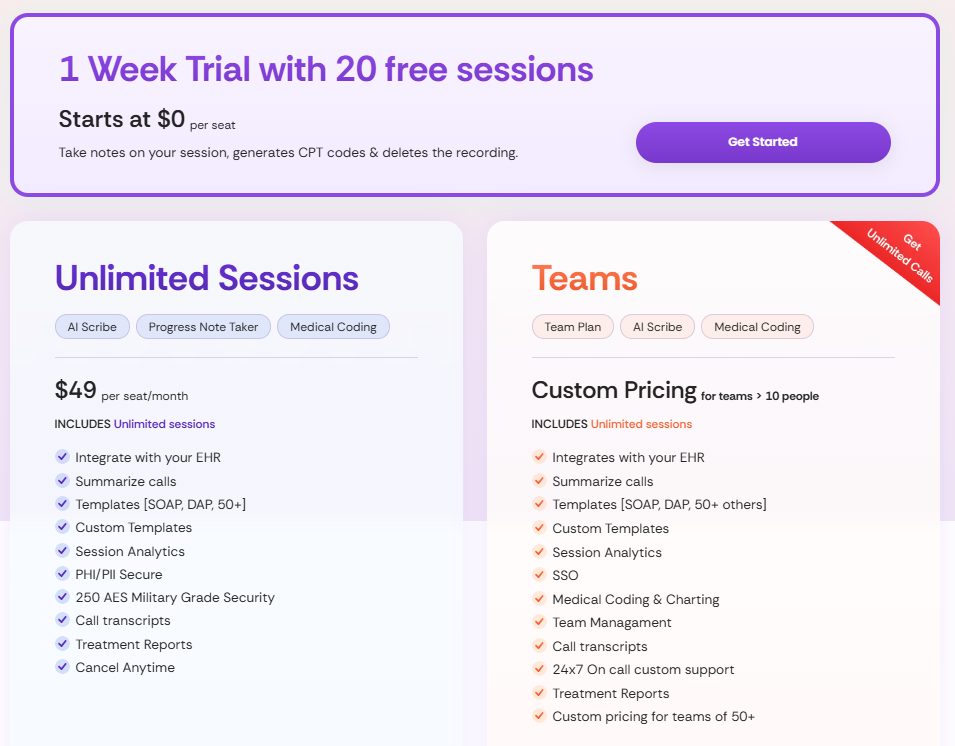Nabla Pricing: Features, Cost, and the Best Alternatives in 2025
AI medical scribes are everywhere in healthcare right now. One name you’ll hear often is Nabla, an AI medical scribe platform built for doctors and hospitals. But what about Nabla pricing in 2025? Is it really worth the cost, or are there better alternatives like HealOS (formerly Scribehealth.ai)?
.jpg)
Choosing the right AI medical scribe isn’t easy. Doctors want accuracy, security, and time savings without paying thousands a month. Nabla promises automation and smarter charting. But some users say it lacks flexibility or gets pricey for larger teams. Nabla pricing in 2025 remains unclear to many practices.
Let’s break it down. We’ll look at Nabla’s pricing, features, and real-world value. Then, we’ll compare it with more affordable options like Nable vs HealOS (formerly Scribehealth.ai), and by the end, you’ll know exactly which AI medical scribe fits your clinic or workflow best.
Nabla: Enjoy Care Again

Nabla is an AI-powered medical scribe platform built for healthcare organizations. It helps doctors save time on charting, reduce burnout, and focus more on patients. It’s a premium solution made for large clinics, hospitals, and health systems that want enterprise-level automation. Let’s look at what Nabla offers and who it works best for.
Nabla AI Medical Scribe Platform Features
Nabla calls itself a platform that “restores the human connection in healthcare.” It replaces manual note-taking with AI-powered documentation across EHRs, helping clinicians spend more time with patients instead of screens.
Some of its top features include:
- Real-time transcription with less than 10 seconds of processing time.
- Context-aware note generation that understands medical terminology.
- Custom templates for over 55 specialties.
- Proactive coding suggestions for ICD and CPT codes.
- Live transcripts during visits for full transparency.
- EHR integration across leading systems.
- Support for 35+ languages, including English and Spanish.
Nabla also offers what it calls an “agentic AI platform.” This means the AI doesn’t just transcribe, it actively assists. There’s a Context-Aware Agent, a Proactive Coding Agent, and a Care Setting Agent that adapts to different environments like hospitals or telehealth.
The company claims 90% burnout reduction among users and 81% better patient-clinician interactions. It’s clearly designed for organizations that want reliable, large-scale automation with premium support.
Learn the difference between AI Medical Scribe vs Human Scribe: Benefits and Costs
Ideal Customer Profile
Nabla isn’t built for everyone. It’s positioned as a premium enterprise solution, not a self-serve app.
Nabla is best suited for:
- Large health organizations want an enterprise-grade AI medical scribe that can interact with sophisticated EHR systems.
- High-volume specialty practices, such as primary care, psychiatry, and cardiology, require real-time AI transcribing and coding accuracy.
- Burnout-prone healthcare teams want to reduce after-hours charting and improve work-life balance using AI automation.
- Enterprise decision-makers (CMOs, IT directors, and practice administrators) require a HIPAA-compliant AI scribe platform with proven scalability.
However, Nabla may not be the best option for everyone; inexpensive products such as HealOS (formerly Scribehealth.ai) provide similar documentation automation without the enterprise price tag.
How Much Does Nabla AI Medical Scribe Cost in 2025?
Nabla pricing isn’t always clear. Many clinicians look for a straightforward price list and end up finding mixed numbers online. So, how much does Nabla AI actually cost in 2025?
Let’s break it down.
How Much Does Nabla Cost?
Nabla doesn’t list its prices publicly. You won’t find a Nabla pricing page on its website, only a “Request a Demo” button. That means to get a quote, you have to talk to sales first. Still, based on verified reports and customer feedback, Nabla appears to offer three main pricing tiers in 2025 — Free, Pro, and Enterprise. Here’s what most users report.
Free Plan
- Up to 30 consultations per month
- Basic AI documentation features
- EHR integration included
- HIPAA and GDPR compliance
Pro Plan
- Estimated $119/Month per User
- Unlimited consultations (no usage caps)
- Full EHR integration across major systems
- Advanced AI note generation with automatic coding
- Real-time transcription and multi-device access
While Nabla has not confirmed the price, various sources and evaluations indicate that $119 per month is the going fee for individual users in 2025.
Enterprise Plan
Custom Quote
- Tailored AI models and workflows
- SAML SSO and enterprise-grade security
- Dedicated onboarding and white-glove support
- Custom data storage and compliance options
What Affects Nabla Cost?
Several factors influence how much your practice will pay.
1. Plan Selection
Free users get limited access to 30 consultations per month. The Pro plan removes those limits at $119/month. Enterprise customers pay custom rates based on organization size and features.
2. Number of Users
Nabla charges per provider. A clinic with 10 users pays $1,190/month. Larger teams often qualify for discounted enterprise pricing.
3. Usage Volume
The free plan stops at 30 consultations a month. The Pro plan offers unlimited use, no overage fees. It’s ideal for doctors seeing 20+ patients daily.
4. Integration Requirements
All plans include basic EHR integration. Custom integrations or advanced security (like SAML SSO) are reserved for Enterprise clients.
5. Support Level
Free and Pro users get self-service support. Enterprise customers receive a dedicated success manager and priority assistance.
Is Nabla Worth the Price?
Nabla is a strong choice for:
- Medium to large practices (5+ providers).
- Specialty clinics need complex note customization.
- Healthcare systems focus on quality and accuracy over cost.
- Global or bilingual teams requiring multi-language documentation.
- High-volume providers seeing 20+ patients a day.
Pros and Cons of Nabla
Like any healthcare AI tool, Nabla has strengths and weaknesses. It’s powerful and enterprise-grade, but not every clinic needs that level of tech or that price tag.
Pros
- Real-time transcribing generates accurate medical notes in under 10 seconds.
- Multi-specialty support for prebuilt templates is compatible with over 55 specialties.
- EHR integrates with main systems to provide a seamless workflow.
- Advanced AI utilizes proprietary large language models to improve context and reduce errors.
- Enterprise support includes onboarding assistance, compliance setup, and white-glove service.
Cons
- No public pricing: Nabla doesn’t share prices online. All quotes require a sales call.
- Premium cost: Overall, Nabla’s AI scribe pricing sits higher than budget-friendly alternatives but offers premium reliability.
- Complex setup: Designed for enterprise use, not solo or small practices.
- Learning curve: Takes time to customize templates and workflows.
- Limited transparency: Setup costs and contract terms aren’t clearly disclosed.
If you want similar accuracy and compliance at a lower cost, check out HealOS (formerly Scribehealth.ai), the best Nabla alternative in 2025 for small and mid-sized practices.
HealOS (formerly Scribehealth.ai): AI Medical Scribe

HealOS (formerly Scribehealth.ai).ai, the best Nabla alternative for 2025, gives healthcare teams a simpler, more affordable path to automation. It’s built for doctors who want accurate notes, zero setup stress, and clear pricing from day one.
Key Features
HealOS (formerly Scribehealth.ai) delivers everything you’d expect from a premium AI medical scribe without the premium cost.
- Real-time voice recognition that listens, understands, and writes medical notes automatically.
- Comprehensive note formats like SOAP, HPI, and specialty templates for different medical fields.
- Automated medical coding to simplify billing and ensure compliance.
- Seamless EHR integration with Epic, Cerner, AllScripts, Jane, and others.
- Secure APIs following HL7/FHIR standards.
- Built-in telehealth support that captures patient visits directly from video platforms.
- Unlimited sessions — no per-note or per-minute fees.
- HIPAA-compliant infrastructure with end-to-end encryption and automatic audio deletion after transcription.
Pricing
One of the biggest advantages of HealOS (formerly Scribehealth.ai) is how transparent the pricing is. No demos. No quotes. No surprises. HealOS (formerly Scribehealth.ai) offers simple monthly plans built around real clinical use:

- Free plan – $0/month for new users testing AI documentation.
- Standard plan – $49/month with unlimited sessions and coding support.
- Enterprise plan – Custom quote for hospitals needing white-glove onboarding and advanced integrations.
At $49/month, HealOS (formerly Scribehealth.ai) costs 59% less than Nabla’s estimated $119/month while offering the same accuracy, compliance, and EHR compatibility. This breakdown helps clinics compare AI scribe pricing in 2025 across multiple platforms. Explore How AI Medical Scribes Deliver a 387% ROI in Year One for Small Practices.
How it Compares to Nabla
HealOS (formerly Scribehealth.ai) keeps things simple. You can sign up, test it for free, and start saving hours instantly.
- Flat $49/month pricing that’s public and transparent.
- Unlimited sessions with no per-minute or per-note limits.
- Instant setup — works right after sign-up, no IT support needed.
- EHR integrations for Epic, Cerner, TherapyNotes, and even veterinary systems.
- HIPAA-compliant infrastructure with automatic audio deletion.
It skips the enterprise complexity and focuses on what busy clinicians really need: accurate notes, fewer clicks, and more time for patients. That’s why many small and mid-size practices switch from Nabla to HealOS (formerly Scribehealth.ai) for everyday, practical automation that just works.
Need help comparing medical scribe tools? Check our guide: Best Nabla Alternatives 2025: Affordable AI Medical Scribes for Every Practice.
Nabla vs HealOS (formerly Scribehealth.ai): Quick Comparison 2025
Nabla vs Other AI Scribe Pricing: How Much Does a Scribe Cost in 2025?
Nabla isn’t the only AI medical scribe out there. Depending on your clinic size, workflow, and budget, there are several options worth exploring in 2025, from budget tools under $50 to enterprise AI scribe pricing $600+ a month. Here are some of Nabla alternatives.
Freed AI

Freed.ai sits in the budget-to-mid tier range, priced around $90/month. It offers custom SOAP note generation, a clean desktop and mobile app, and AI that adapts to each user’s writing style. Direct API access isn't yet accessible, and it's still in beta for EHR integrations. It is ideal for independent practitioners or small clinics seeking an affordable, user-friendly learning AI medical scribe.
Heidi Health

Heidi is priced between $90/month, supporting 23 languages and global data compliance. It’s one of the few platforms offering a free plan, making it accessible for small teams. The downside? Full EHR integration requires a custom quote, and its mobile app is still being developed. Best for international clinics or multilingual practices that need flexible, affordable documentation tools.
Abridge

Abridge is a well-known name with hidden pricing. It’s trusted by systems like Kaiser Permanente for accurate, concise note summaries. However, it’s mainly Epic-focused, and full integration nearly doubles the price. Best for large health systems already using Epic.
BastionGPT

BastionGPT is a newer entrant priced at $20/month. It provides safe document upload and speedy transcription, functioning as both an AI assistant and a medical scribe. Since it is still in its infancy, there aren't many integrations, but tiny clinics or new practices experimenting with AI assistants find its affordability and adaptability appealing.
Final Verdict – Is Nabla the Right Fit for You in 2025?
When comparing Nabla vs HealOS (formerly Scribehealth.ai) pricing, the difference in monthly cost and setup transparency is significant. Nabla is a powerful AI medical scribe, but it’s built for large healthcare organizations. With enterprise integrations, multilingual support, and white-glove onboarding, it’s clearly designed for hospitals and multi-specialty groups with bigger budgets.
For smaller clinics, solo practitioners, or telehealth providers, the lack of public pricing, required demos, and long sales cycles can make adoption slow and expensive. That’s where HealOS (formerly Scribehealth.ai) stands out. It’s simple, affordable, and built for everyday use. You can test it today, use it tomorrow, and keep full control of your workflow every step of the way. Start your free trial now at HealOS (formerly Scribehealth.ai).ai.
FAQs
Does Nabla share its pricing publicly?
No. Nabla does not publish official pricing on its website. Most reports place the Pro plan around $119/month, but you’ll need to book a demo to get an exact quote.
Is Nabla worth the price in 2025?
It depends on your organization's size. For large health systems, Nabla’s enterprise-grade AI, real-time transcription, and multi-specialty support justify the cost.
.png)
